Coyotes are a well-known species of wild dog native to North America. More people are becoming interested in the way coyotes look, which has led to several dog breeds being created that look like coyotes.
This article looks at the top 9 dogs that look like coyotes.
Just bear in mind that few breeds look like a coyote, as this is only a recent trend for breeders. However, there are plenty that were bred to look like wolves that look like coyotes too. This article mentions some of these if they’re close enough.
1. Kugsha

The Kugsha is a dog native to North America and is the result of interbreeding between wolves and dogs.
While this technically isn’t a coydog, it closely resembles the sleek appearance of a coyote, presumably because North American wolves were used.
Kugsha dogs are still very independent dogs and like to have tasks to complete. Similarly, they’re not great to keep around children.
But, providing you’ve got the experience and confidence to look after them, Kugshas form intensely loyal bonds with their owners.
2. Czech Wolfdog

This breed is a cross between the German Shepherd and Carpathian wolves.
Again, this might technically be a wolfdog, but many of the characteristics match up with a coyote.That said, Czech Wolfdogs do have a larger head, although still have quite sleek bodies.
The Czech Wolfdog is quite new in terms of dog breeds but has become very popular. They make great family pets and have all the domestication of German Shepherds behind them.
If you’re looking for a good family pet that resembles a coyote, you could do much worse than one of these.
3. Shikoku Ken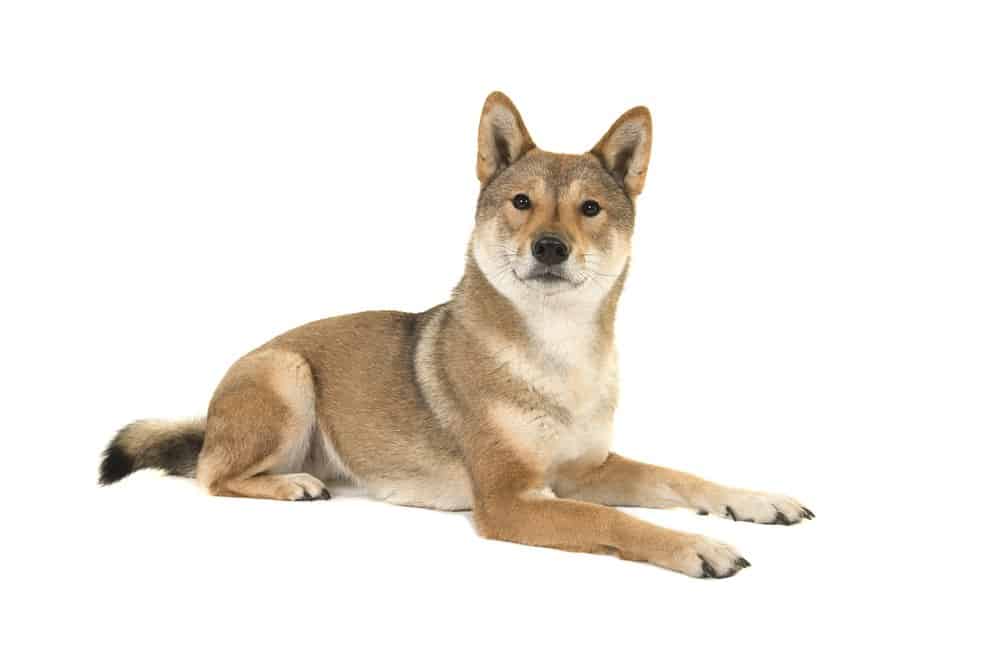
The Shikoku is a spitz-type dog from Japan that looks a lot like a coyote.
The Shikoku has a long face, pointy ears, and a curly tail. While its ears are a similar shape to a coyote’s, they’re not as long.
Also, the Shikoku has the same colored fur, but it’s much fluffier. The Shikoku is very similar to the Shiba Inu, and both are popular breeds in Japan.
The Shikoku is less well known outside of Japan, but there are breeders all over the world. The breed is known to be friendly and playful, and so make great family dogs.
4. Utonagan

The Utonagan originated in England and was bred from the desire for a wolf-looking dog.However, the resulting breed also looks a lot like a coyote, as it has a similar shape face and ears.
The Utonagan is longer and thicker in the body than a typical coyote, though.
They’re known as an intelligent and friendly breed that can learn tasks and commands very quickly.
However, they require plenty of exercises, otherwise, they can become destructive. Also, they get on much better in cold weather than in hot.
5. Saarlos Wolfdog
The Saarlos Wolfdog originates in the Netherlands but is surprisingly one of the dog breeds that look most similar to a coyote.They have the same elongated face and legs, along with the slim body and even similar colored fur.
However, they are much larger and are identical in size to a German Shepherd.
Saarlos Wolfdogs were bred as working animals, and so are very clever and energetic.
This means that it takes a certain kind of household to look after them properly, as the dogs need plenty of exercise and stimulation. However, if managed correctly, they make great family pets.
6 Canadian Eskimo
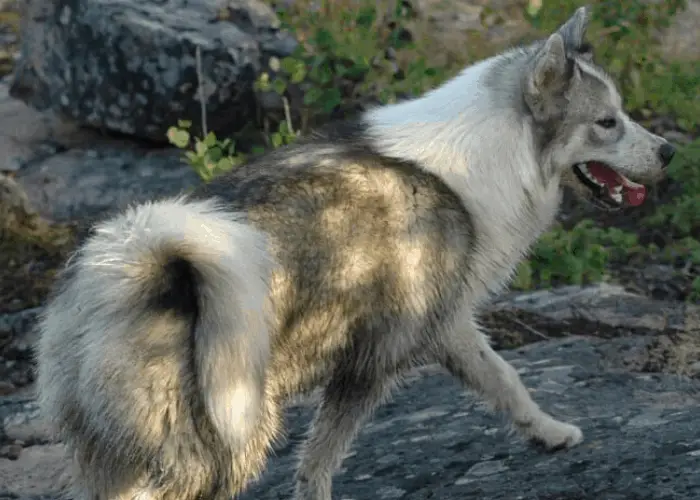
Large in stature, the Canadian Eskimo dog (also known as the Canadian Inuit dog) weighs between 66 and 95 pounds and has a coat of white fur (30 to 43 kilograms).
The dog is formed like a giant husky or malamute, and it has a powerful bite. The skull is wedge-shaped, and the ears are tiny and pointed. They are almond-shaped and dark brown to amber in hue, with a dark brown iris.
Blue eyes indicate an impurity and a curled over the back tail like a traditional husky. Canadian Eskimo dogs achieve maturity at roughly three years of age, while they reach their peak size at around a year of age as well.
Being similar to a husky, the Canadian Eskimo dog has the following similarities with a coyote:
- Powerful and vocally howl.
- Both intelligent.
- Same average life span.
7. Italian Wolfdog

In Italy, the Italian Wolfdog, also known as the “Lupo Italiano,” is a huge wolfdog hybrid created by breeding an Apennine female wolf with a German Shepherd male.
Its many characteristics are a solid body, a powerful abdomen, a well-built spine, long, muscular limbs, and a low thick tail. In addition, the Lupo Italiano has high levels of sensory acuity, like do wolves, and a high degree of resilience to exhaustion.
The Lupo Italiano has the following similarities to a coyote:
- Both are used to a mountain environment
- Same average life span
- Both have keen senses
8. Siberian Husky
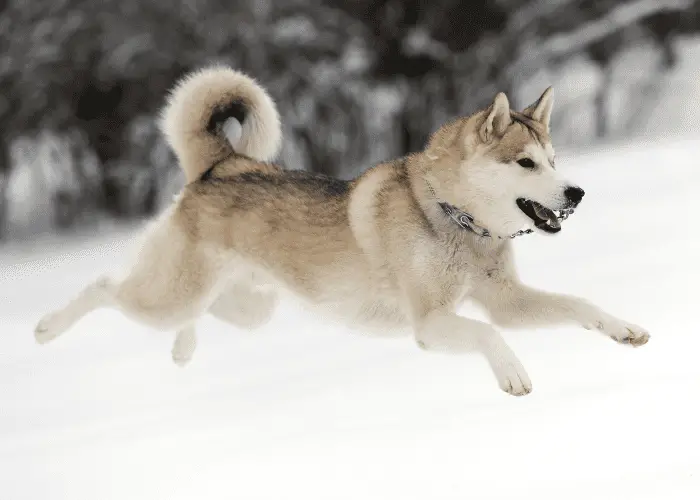
Even though a Siberian Husky would most likely appear more like a wolf than a Coyote, these dogs are nevertheless worth noting since it is easy to mistake one for something that it is not at first glance. The Husky has a thick, furred double coat and will flourish in colder climates because of this.
The Siberian Husky is an excellent family dog that will provide years of enjoyment. A Husky has a lot of energy and will need to burn it off, yet they have a kind temperament and are gentle.
Huskies are excellent with children, and they may grow to reach approximately 50 pounds, occasionally a little more, depending on the breed. Siberian Huskies from Russia have a relatively long life for a giant breed dog of their size. They are predicted to survive somewhere between 12 and 15 years in the wild.
The Siberian Husky has the following similarities to a coyote
- Same average life span
- Averaging the same weight
- Used to a mountain environment
- Thick amount of fur
9. Samoyed
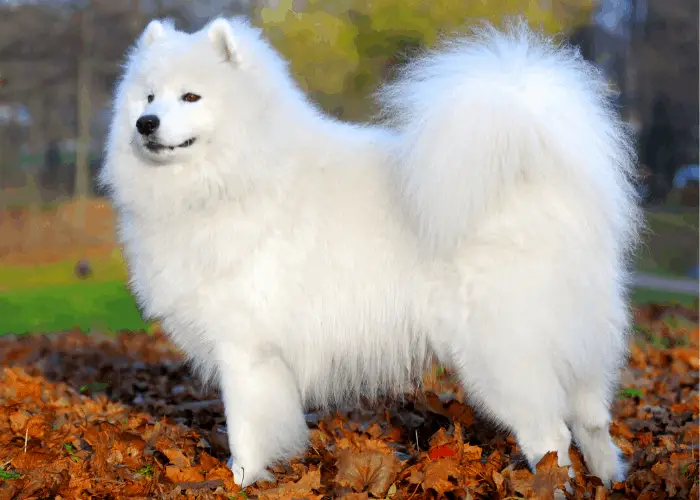
The Samoyed dog breed, created initially to hunt, tow sleds, and herd reindeer, proved to be a great companion for the Samoyede people of northern Siberia. Pack hiking, tracking, and lying on top of their owners at night are just a few of the breed’s responsibilities.
Being a working breed, Samoyeds may be stubborn at times, but they are above all kind, gentle, and dedicated family dogs. They’re friendly with practically everyone, as long as newcomers don’t mind a little shedding and stray hairs on their clothing.
Samoyeds similarities to a coyote:
- Bark/howl a lot
- Intellect
- Used to colder weather
- Social creatures
How Do Coyotes Look?
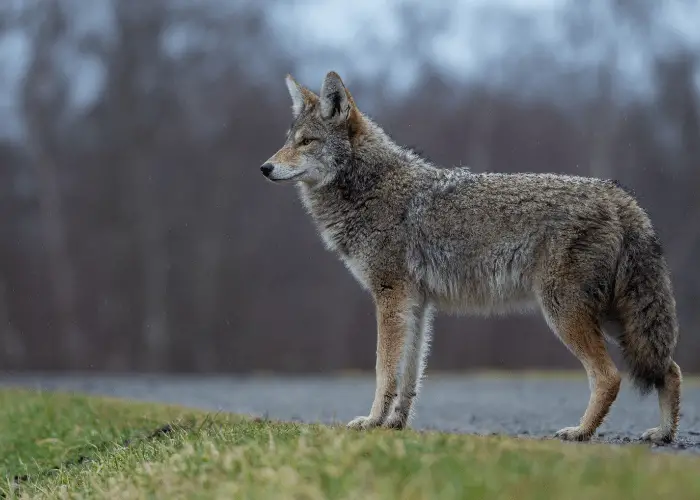
Coyotes are also known as the American jackal due to their similar appearance to a jackal, which is native to Eurasia.
While they fulfill a similar niche in the food chain to wolves, their appearance isn’t all that similar. Coyotes are generally smaller and more slender than wolves.
A male coyote can weigh between 18 and 44lbs, while a female coyote can weigh between 15 and 40bs.
This massive variation is a result of the 19 different subspecies, which range across the whole of North America. Generally, species found further north are larger and heavier.
Although color can vary depending on location, most coyotes have a coat that’s red and gray, with some black and white included.
Coyotes found in the north are generally more gray and black, while those in the south are red and white. This is mainly due to camouflage.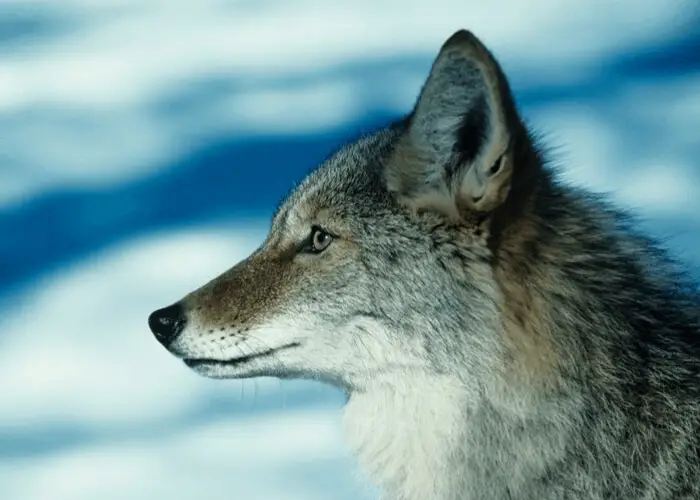
Much like domestic dogs, coyotes have a double-layered coat that consists of a short, soft undercoat and a longer, wiry topcoat.
This helps to provide the coyote with insulation and protection against the elements.
Coyotes are slightly smaller than the gray wolf, which is probably the best-known type of wolf in the world.
However, coyotes have larger ears, and their skull is also slightly larger (in relation to the size of their body).
Similarly, coyotes are generally thinner than wolves, and they carry their tail down while running, whereas wolves hold it horizontally while moving. However, much of their predator behavior is the same.
How Can You Tell The Difference Between A Coyote And A Dog?
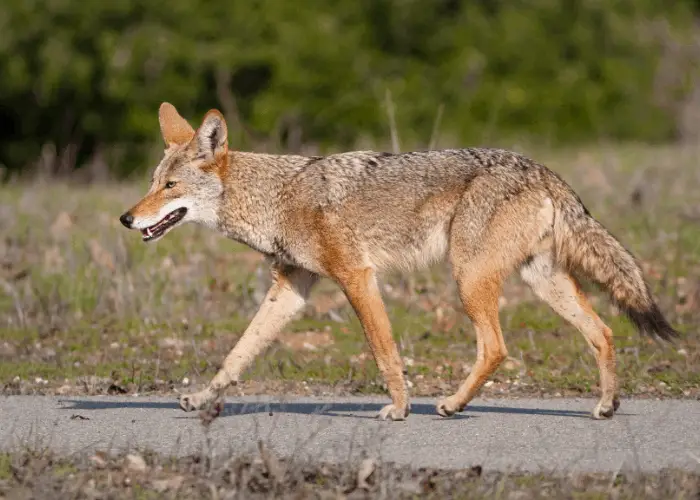
Hopefully, there won’t be too many times when you need to try and tell the difference between a coyote and a dog, but knowing the information can be useful.
Depending on the type of dog, there can either be loads of differences, or not that many.
Also, it’s worth mentioning that by a dog, we’re referring to domesticated species of dogs.
The coyote is a member of the dog family (Canis), as are wolves. As a result, there’s always going to be some level of similarity. Again this depends on which breed of dog you’re comparing it against.
The most significant difference between a coyote and a dog is the shape of their body. A coyote is generally much sleeker than a comparable breed of dog, and have a more pointed nose and flatter head.
As mentioned, their ears are also very long compared to a similar size dog.
Coyotes have quite long legs, but in comparison to a dog, their legs are shorter based on their body size.
This is because the top part of a coyote’s leg is longer, meaning their elbow is lower to the ground. It gives the impression of them having very long legs, but it’s just that they’re a different shape.
The final major difference is in the shape of a coyote’s tracks compared to a dog. Coyotes have longer tracks, meaning their paws are a longer shape than a dog’s.
Obviously, a bigger dog will have bigger paws than a coyote, but a dog’s tracks are generally short and squat, while a coyote’s are long and thin.
So, the main differences are:
- Coyotes are generally sleeker, while dogs are bulkier with a deeper chest.
- Dogs have longer legs (proportionately), but a coyote’s elbows are lower to the ground, making their legs seem longer.
- Coyotes have longer, thinner tracks, whereas dogs have shorter, squatter tracks.
Much of this will depend on what breed of dog you’re comparing the coyote too. The ones that look most similar are mentioned below, so you can decide for yourself how big the differences are.
Can A Dog Be Part Coyote?
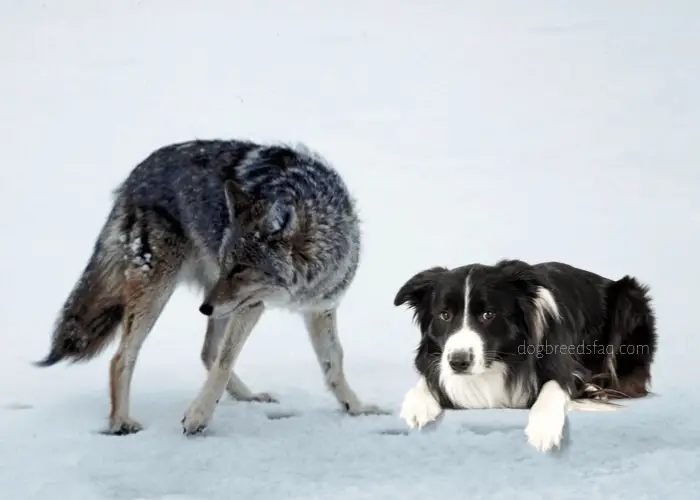
Because coyotes and dogs are from the same family, they’re closely related enough to be able to mate and produce offspring.
While this obviously isn’t true of all members of the same genetic families, it is in this case.
This is mostly because domestic dogs descend from wolves, and so while their appearances may vary massively, their genetics actually don’t.
In fact, people have been breeding coydogs (coyote-dog hybrids) since before Columbus discovered Mexico.
However, nowadays, most coyote-dog hybrids are only found in the wild, as the resulting puppies aren’t particularly suitable for domestic living.
They contain too much coyote, which leaves them (understandably) quite wild. If you like the look of a coyote, you’re much better finding a breed of dog that looks like one.
Various studies have been conducted on F1 coyote hybrids (which are first-generation babies from distinct parents).
It was found that coydogs don’t take well to domestic living, and aren’t as useful as wolf-dog hybrids when it comes to being working animals.
Conclusion:
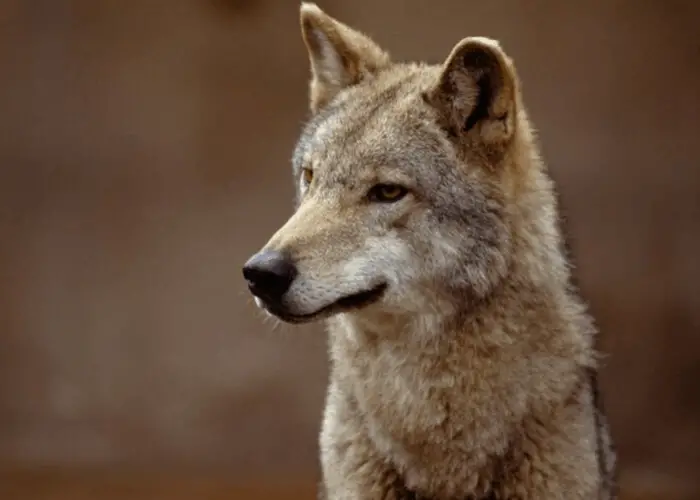
Some people are interested in the appearance of coyotes, which is completely understandable.
They have a wild, rugged look, but are also very intelligent and inquisitive animals.
However, because coyotes haven’t been domesticated successfully, it’s best to find a breed that just looks like them.
While you might have a chance of adopting a coydog, this isn’t a good idea. As mentioned, they don’t behave in captivity and can be very destructive.
So avoid adopting a coydog and just find a breed that looks like them.
Finding a breed of dog that looks like a coyote might not be the easiest thing, but there are a few out there.
Hopefully, this article has helped you learn what a coyote looks like.
Now, you’ll be much better equipped to go out and find the right breed to adopt (if that’s what you’re thinking of).
[ Check Out Our Other Article: Below:- Dogs that look like Eevee of Pokémon
- Horses Look-Alike Dogs

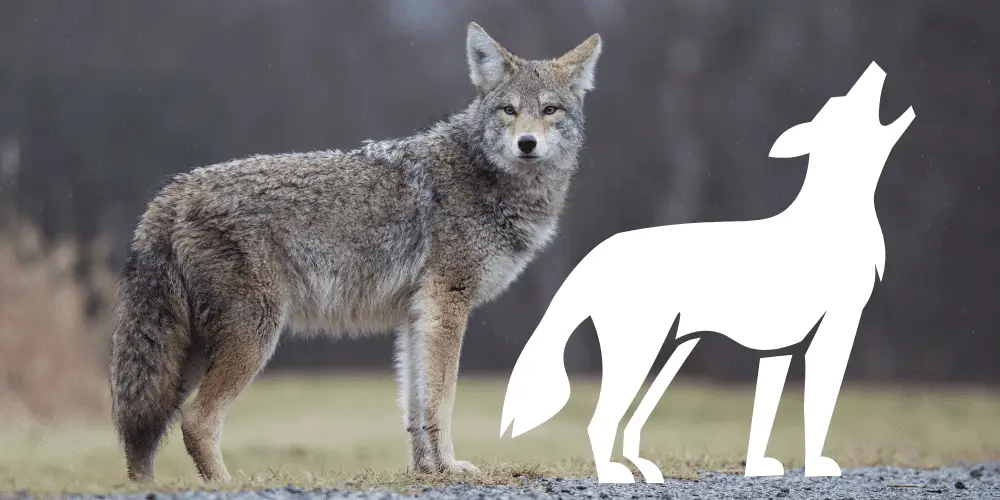
file:///var/mobile/Library/SMS/Attachments/9b/11/62FC030D-7384-4038-A92D-7EC95A6146D3/123_1.jpeg
A friend of mine though this was a dog and put it in her car turns out it was a coyote. Thanks to a neighbor of hers who saw it and called animal control and told my friend mama that is not a dog she fed it and gave it water. I am so glad the coyote didn’t attack or even worst.